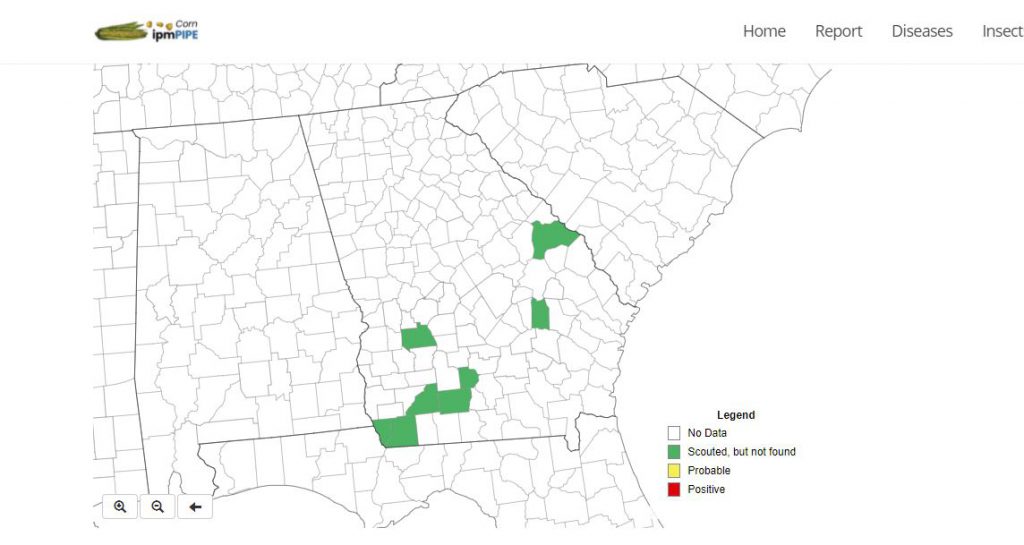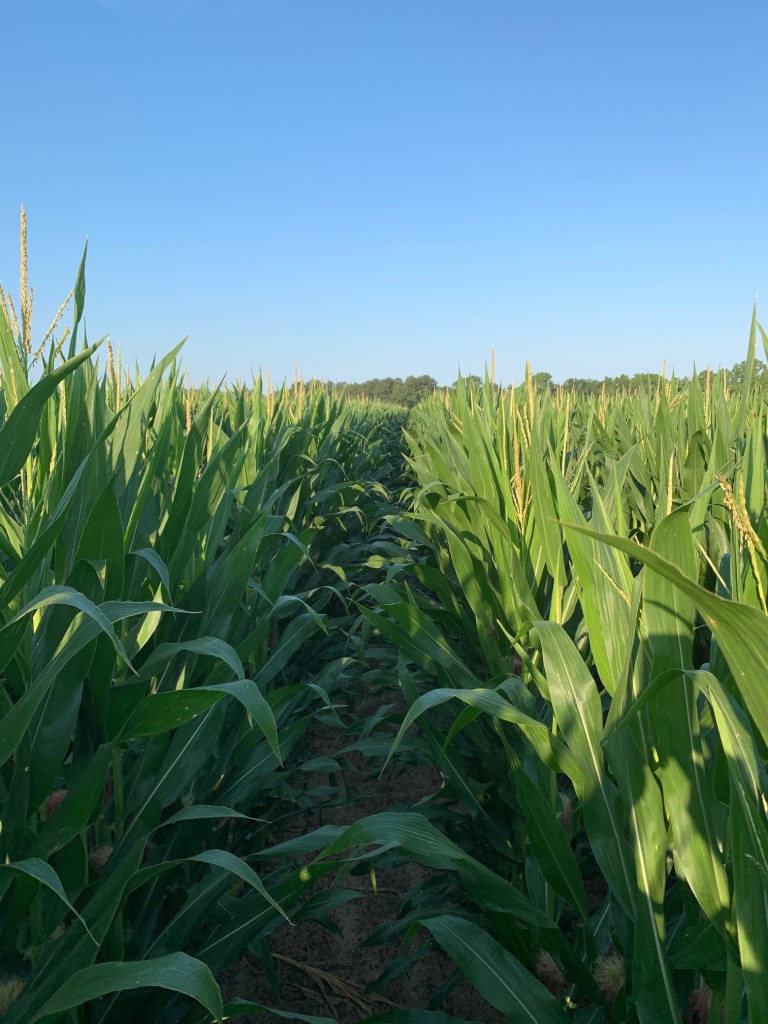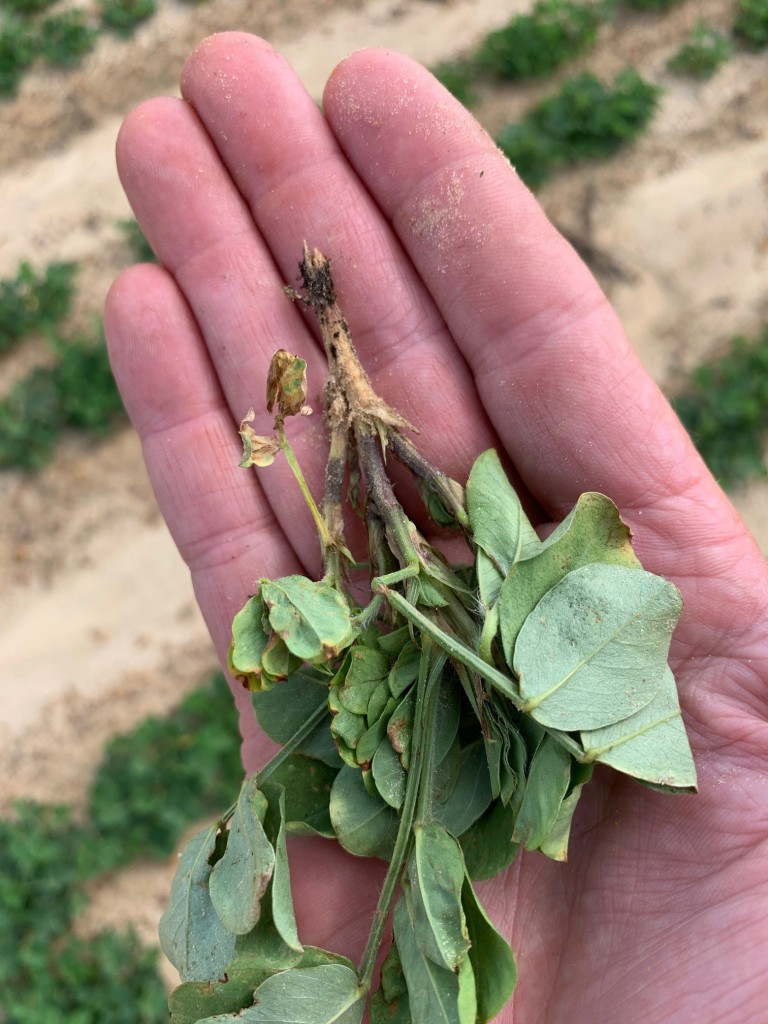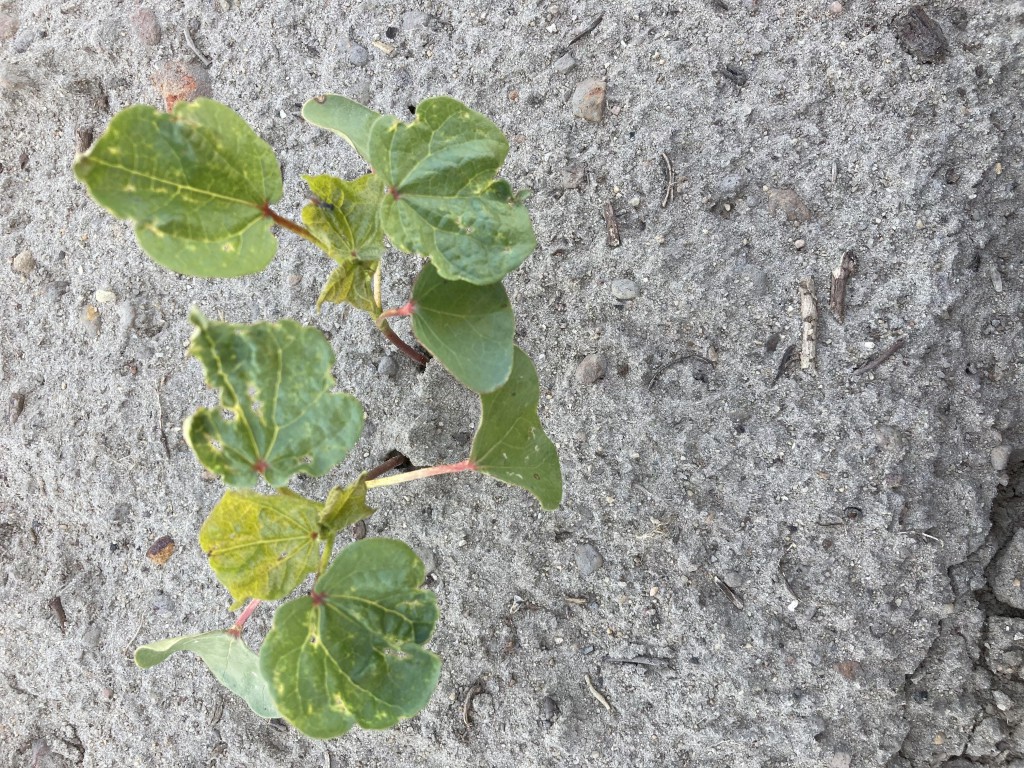Current Situation: Happy Memorial Day! The majority of the cotton and peanut crop is planted. Corn is reaching critical moisture requirements as the crop is approaching tassel and pollination. Peanut growers are asking about cracking spray options. Cotton growers are starting to apply weed control and thrips pressure has been high in some area fields.
Corn: According to Bob Kemerait, UGA Plant Pathologist, no Southern Rust has been reported in Georgia at this time (May 31, 2021) . If you would like more information on the current status of Southern Rust please go to https://corn.ipmpipe.org/southerncornrust/
The image below illustrates the current status of Southern Rust in Georgia as of 5-30-21.

The majority of corn in this area is approaching or has reached tassel emergence, the irrigation requirements are increasing. Below is a table showing water requirements for corn at tassel until milk stage of development. Now is not the time to fall behind on corn irrigation. With most of our corn moving into peak water usage some systems may need to run almost continually over the next few weeks. Just keep this in mind, if we deplete our deep soil moisture now we will struggle to replenish it without a good soaking rainfall.
Water Requirements of Corn from Tassel until Milk Stage of Development in inches per day.


How late can I apply nitrogen through the pivot on my corn? If nitrogen is to be injected through the irrigation system, apply 40 to 60 pounds at or before planting and begin ground or injected applications of 30 to 60 pounds of nitrogen per acre when the corn is 8 to 12 inches tall. Continue on a bi-weekly basis until the total required nitrogen is applied. Three to five applications of nitrogen will be needed during the growing season. Nitrogen applications after pollination are NOT recommended unless a severe nitrogen deficiency is detected.
What about boron on corn? I had a question or two about boron applications at tassel on corn. According to the UGA Plant Tissue Analysis Handbook, deficiency is not likely to occur, except on very sandy low organic matter soils. Boron deficiency can result in poor ear formation. It is best to apply boron with the nitrogen applications.
How do I take a tissue sample on corn before and after tassel? If you are prior to tasseling then collect the leaf below the whorl. If you are sampling at tasseling, then collect the ear leaf before the silks turn brown.
According to the UGA Plant Analysis Handbook
If B is low at the leaf below the whorl stage, apply 2 pounds of B per acre through the system. Split the application, applying 1 pound per acre as soon as possible and the remainder just prior to tasseling.
If B is low at the ear leaf stage and poor ear development is noted in the current crop, include B in future corn fertilizer programs at the rate of 2 pounds B per acre. No corrective treatment is recommended for current crop if B is low at the ear leaf stage. Boron may be high in soils where B fertilizer has been applied for other crops. Boron levels greater than 30 ppm are excessive. Since corn is quite sensitive to B, great care needs to be exercised when this element is included in fertilizer treatments.
You can access the UGA plant analysis handbook at the following link
https://aesl.ces.uga.edu/publications/plant/
Peanuts: I have been seeing Aspergillis Crown Rot in a few dryland peanut fields around the county. Diagnostic symptoms include 1) rapid wilt of plants SCATTERED in the field, 2) shredded tissue in the crown of the plant, and 3) often, but not always, black, sooty sporulation in the damaged area. Below is an example of what I am noticing.

Who is at most risk to Aspergillus crown rot?
From above, Aspergillus crown rot is more of a threat during early-season periods of hot and dry weather. Once the tap-root of the peanut plant “hardens off” and becomes less succulent, the peanut plant is less susceptible to this disease. Aspergillus crown rot occurs more commonly in non-irrigated fields where irrigation cannot be used to cool the soil; Aspergillus crown rot also occurs more commonly where poor seed quality is an issue.
Management of Aspergillus crown rot
- Use high quality seed. Saved- seed may be at increased risk to Aspergillus crown rot.
- Use a good fungicide seed treatment (preferably Rancona over Dynasty PD specifically for Aspergillus crown rot).
- Consider use of an in-furrow fungicide. Azoxystrobin is more effective on Rhizoctonia seedling disease and less effective against Aspergillus crown rot. Products that contain fluopyram (Velum and Propulse) have better activity against Aspergillus crown rot than does azoxystrobin.
- Take steps to control lesser corn stalk borers.
- When available, use irrigation to reduce threat from Aspergillus crown rot. Growers sometimes fear that irrigation will spread the disease, but in reality there is little if any “in field” spread. Irrigation to reduce stress on the plant and help them develop as quickly as possible is a positive step toward control. It also helps reduce damage from lesser corn stalk borers.
Peanut RX — Fungicide applications on peanuts are just around the corner. Growers need to start thinking about fungicide programs. Earlier in the year, I shared information about Peanut Rx fungicide programs. You can also find more information on Peanut Rx 2021 at https://peanutrx.org, and at UGA Peanut peanuts.caes.uga.edu.
Cotton: The area cotton crop ranges from just being planted to 4-5 leaf stage. Thrips pressure has been moderate to high in some fields. According to Dr. Phillip Roberts, UGA Cotton Entomologist, seedlings are most sensitive to yield loss during early developmental stages. 1-2 leaf cotton is at greater risk to yield loss from excessive thrips injury compared with 3-4 leaf cotton. Once cotton reaches the 4-leaf stage and is growing rapidly, thrips are rarely an economic pest. Below is an example of thrips pressure in some area fields.

Cotton weed control programs!! Selecting the ideal postemergence herbicide system to control weeds while minimizing cotton injury is challenging. The table below provides several suggested systems, but of course growers need to adjust programs to fit the weeds and environmental conditions present at application time. This information is from the 2021 UGA Cotton Weed Control Programs.

When can I start grazing my pearl millet? Pearl millet can be grazed or harvested as hay or silage. Researchers at Tifton have found that pearl millet grazing should begin when plants reach 20 – 24 in. height, but regrowth rate and animal performance is best if a 9 – 12 in. stubble height is maintained. Pearl millet can make good quality hay if cut when plants reach 2 – 3 ft tall. This prevents the forage from maturing beyond the boot stage and therefore being too mature to provide high quality. The drying rate of millet hay can be sped up by the use of a roller/crimper-style conditioner.
Have a great week..
Jeremy M. Kichler
County Extension Coordinator
Colquitt County
